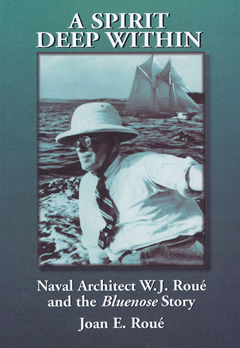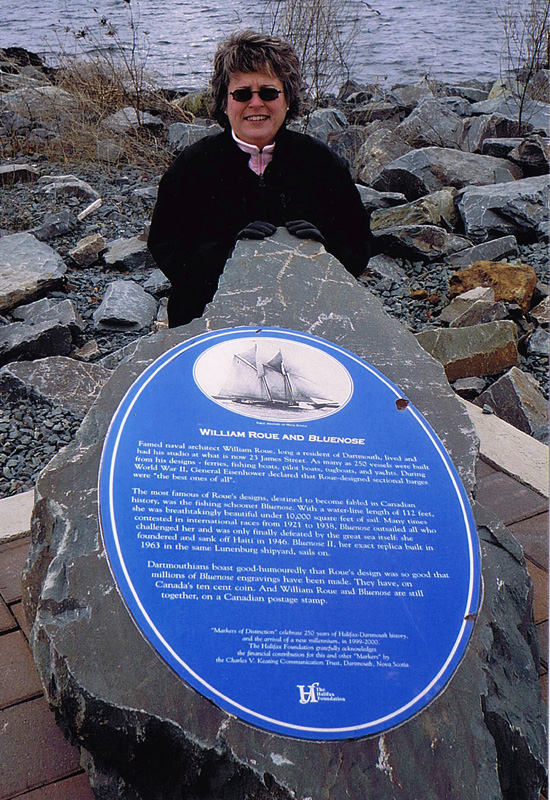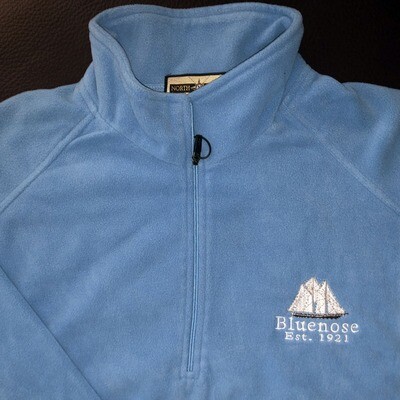by R.F. Latimer
This well crafted and engaging book provides a long-overdue account of the outstanding talent and genius of naval architect, William J. Roué, who used the then little-known design method of mathematical calculations in fashioning the concept of Plan No. 17, the renowned schooner ‘Bluenose’, some 75 years ago.
Obviously, authour Roué, pronounced Ru-ee, the honoured Great Grandaughter of the celebrated ‘Bill’, as he was known to his host of friends, has carefully researched her subject and the book’s content is articulate and well-presented.
The book embraces two distinct parts which essentially describe, in Part 1, the development of Plan No. 17, a winning design, the vessel’s many successes as a fisherman and racer, recognition of Roué, the tragic loss of ‘Bluenose’, as well as the manner in which the spirit lives on in her namesake ‘Bluenose II’.
In Part 2, author Roué tells of the special features and specifications of Design No. 17, together with details of the notably accepted and highly respected Roué-designed ‘Roue-20’ and ‘Bluenose Class’ sloops which continue to sail today.
The Appendix portrays highlights of designer Roué’s distinguished career, a table of his many successful ship designs, in addition, the Racing Log of the exceptional schooner ‘Bluenose’, as well as a diary of the sailing career of ‘Bluenose II’.
Author Roué’s material has been well chosen in focusing upon the name W.J. Roué, a pioneer in the field of naval architecture, his remarkable roll which recognized him throughout the Western Hemisphere with striking prominence in his field, as well as his outstanding design of Plan No. 17. In 1931, W.J.Roué was included in the publication ‘Prominent Men of Canada’.
To perpetuate the name of W.J. Roué, as author Joan Roué has so capably done, in featuring the man who wrote an integral chapter of our Maritime history and who has been honoured for his distinctive accomplishments, indicates her love and respect for her ‘not your ordinary Great Grandaddy’ and I commend her for taking the time, interest and forbearance to structure, in guarded detail, this fine contribution to Canada’s maritime history. Indeed, Bill would be pleased to know how well you wrote about him.
This worthy book, in my opinion, should be appraised as a required reference in Canadian schools, universities, and museums and should have wide appeal for those who are interested in knowing how Canada’s ‘Queen of the North Atlantic’ became a reality.
R.F. Latimer, from Dartmouth, Nova Scotia, was a frequent visitor with W.J. Roué at his Dartmouth home/office.
 Early in his long and productive career, naval architect William James Roué designed a schooner whose performance as a working and racing vessel would make her name and image immortal. The Bluenose, beloved and revered, lives on today in her namesake, Bluenose II which, after much controversy, received a new lease on life through a major refit in 1995. From family anecdotes and papers, research and interviews, Joan Roué tells the Bluenose story with a difference – through the life and career of W.J. Roué, her designer, and one of Canada’s pioneers in the field of naval architecture.
Early in his long and productive career, naval architect William James Roué designed a schooner whose performance as a working and racing vessel would make her name and image immortal. The Bluenose, beloved and revered, lives on today in her namesake, Bluenose II which, after much controversy, received a new lease on life through a major refit in 1995. From family anecdotes and papers, research and interviews, Joan Roué tells the Bluenose story with a difference – through the life and career of W.J. Roué, her designer, and one of Canada’s pioneers in the field of naval architecture.









